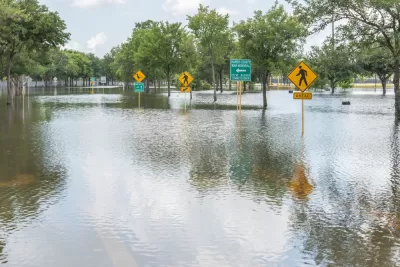The controversy over the flooding of the Addicks Reservoir outside Houston seems to have no resolution in site. What follows is a cautionary tale about building homes where waters flood.

Dylan Baddour reports from the city of Houston:
Six months after the Addicks Reservoir hit its highest point on record during the Tax Day flood, swelling up out of its theoretical bank and into the Bear Creek subdivision on its northwestern edge, residents there bemoaned the lingering effects. Beside financial ruin, some said, they still were living out of boxes and replacing appliances. And they were living in terror of the next big rain.
In September, Lauren Caruba devoted feature-length coverage to the looming threat represented by the dam holding back the water in the Addicks Reservoir. According to Baddour, "tension mounted," as U.S. Rep. Ted Poe (R-Tex) recently convened an expert panel to discuss the threat of flooding in the area.
"The audience wanted to know why the Addicks reservoir had infiltrated their living rooms, and what could be done to prevent it from happening again," according to Baddour. They were met with explanations about the how the U.S. Army Corps of Engineers' management mandates require they protect Houston above all other priorities.
In addition to the priority given to Houston by the Army Corps' stormwater management priorities, residents in the Bear Creek subdivision report being unable to acquire FEMA grants to raise their homes.
A FEMA spokesman said that limited grant money was managed by state and local authorities. "They set priorities for which areas they want to target," he said. This time, it seems they targeted Houston.
One possible source of relief could be coming from the federal government, where the Senate has approved $500 million in relief for 2016 floods in Texas, Louisiana, West Virginia, and Maryland. If the House passes that legislation and the president signs, some of that money could go to home repairs in the Houston area.
FULL STORY: Exasperation overflows as hundreds gather for Bear Creek flooding panel

Maui's Vacation Rental Debate Turns Ugly
Verbal attacks, misinformation campaigns and fistfights plague a high-stakes debate to convert thousands of vacation rentals into long-term housing.

Planetizen Federal Action Tracker
A weekly monitor of how Trump’s orders and actions are impacting planners and planning in America.

San Francisco Suspends Traffic Calming Amidst Record Deaths
Citing “a challenging fiscal landscape,” the city will cease the program on the heels of 42 traffic deaths, including 24 pedestrians.

Defunct Pittsburgh Power Plant to Become Residential Tower
A decommissioned steam heat plant will be redeveloped into almost 100 affordable housing units.

Trump Prompts Restructuring of Transportation Research Board in “Unprecedented Overreach”
The TRB has eliminated more than half of its committees including those focused on climate, equity, and cities.

Amtrak Rolls Out New Orleans to Alabama “Mardi Gras” Train
The new service will operate morning and evening departures between Mobile and New Orleans.
Urban Design for Planners 1: Software Tools
This six-course series explores essential urban design concepts using open source software and equips planners with the tools they need to participate fully in the urban design process.
Planning for Universal Design
Learn the tools for implementing Universal Design in planning regulations.
Heyer Gruel & Associates PA
JM Goldson LLC
Custer County Colorado
City of Camden Redevelopment Agency
City of Astoria
Transportation Research & Education Center (TREC) at Portland State University
Jefferson Parish Government
Camden Redevelopment Agency
City of Claremont





























